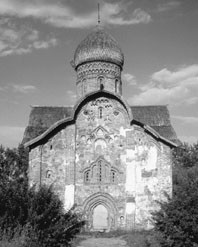

 | Page 953 |  |
individual households, including the homes of artists, craftspeople, nobles, and slaves (Rybina 2001).
A most interesting feature of medieval Novgorod was the existence of thousands of documents scratched onto birchbark pages (beresty), of which almost 1,000 have been recovered. These deal with a wide range of subjects and include peasant complaints, financial records, school exercises, notes on literature, and love letters. Other preserved objects include tools, weapons, musical instruments, toys, jewelry, clothes, and craft materials.

A medieval church in Novgorod, Russia
(Image Select)
See also
References
Birnbaum, H. 1996. Novgorod in Focus. Columbus, OH: Slavica Publishers.
Ostman, R. 1997. “‘Our Land Is Great and Rich, But There Is No Order in It’: Reevaluating the Process of State Formation in Russia.” Archaeological News 22: 73–91.
Rybina, E. 2000. “Novgorod.” Pp. 239–241 in Medieval Archaeology, An Encyclopedia. Ed. P.J. Crabtree. New York: Garland Publishing.
Yanin, V.L. 1990. “The Archaeology of Novgorod.” Scientific American 262, 2: 84–91.
Yanin, V.L. et al. 1992. The Archaeology of Novgorod, Russia. Society for Medieval Archaeology, Monograph Series 13. Lincoln.
A late prehistoric settlement and complex of burial sites in Dolenjska (lower Carniola) in slovenia, Novo Mesto is characterized by a number of cemeteries dated from the whole first millennium b.c. The settlement is located on the Marof and was probably occupied from the late–Bronze Age to Roman times. The first excavations of the cemeteries began at the end of the nineteenth century (by the Naturhistorisches Museum, Vienna, and the National Museum, Ljubljana). However, more intensive research was initiated by the Dolenjski Muzej (lower Carniola museum) in Novo Mesto from 1967 onward.
The Novo Mesto cemeteries date to three main periods: late–Bronze Age (ninth–eighth centuries b.c.), early–Iron Age (eighth–fourth centuries b.c.), and the late–Iron Age to the Roman period (third century b.c.–second century a.d). From the first period, the sites of Mestne njive, Kapiteljska njiva, and Brsljin contain some 400 urned cremation graves and were part of the Ljubljana Urnfield group. Grave goods consisted mostly of dress ornaments (fibulae, bracelets, pins) and ceramic vessels. Only a few graves contained weapons (axes, spearheads), razors, necklaces, knives, or glass beads.
The early–Iron Age sites of Kapiteljske njive and Kandija are made up of some twenty earthen barrows. The burial rite was inhumation (from few to seventy graves per barrow). Some rich princely graves of this period were recorded containing body armor, tripod, various helmet types, weapons, and decorated bronze vessels together with numerous warrior graves and graves with standard personal ornaments and ceramic vessels. In the early–Iron Age period, Novo Mesto was one of the most important centers of the Dolenjska (lower Carniola) group of the Hallstatt culture.
The late–Iron Age sites of Kapiteljske njive, Kandija, and Beletov vrt are characterized by cremation burials in flat cemeteries. Graves contain mostly middle and late la tène artifact types (swords with scabbards, shields, knives,
 |  |